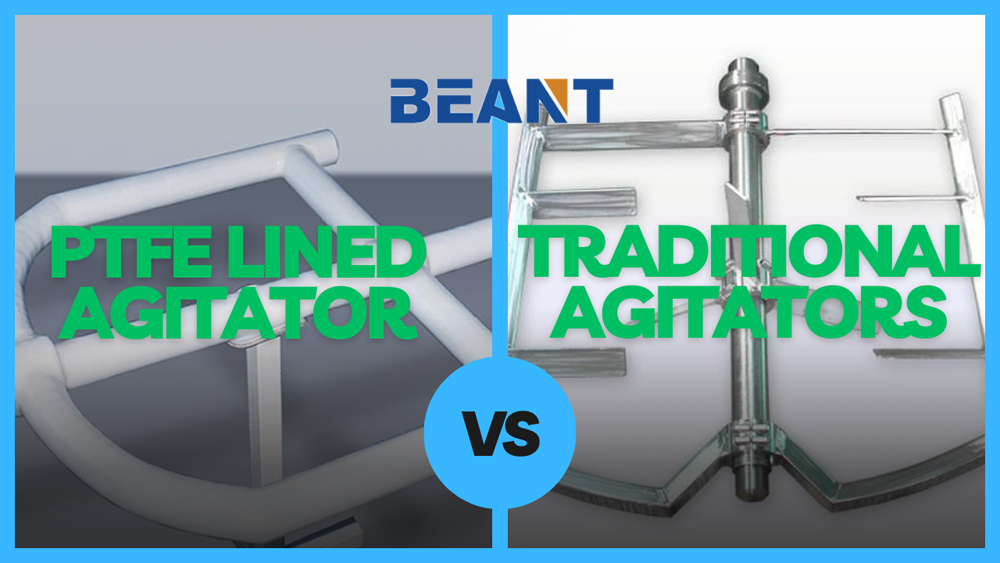
Agitators play a crucial role in numerous industries, ensuring the homogeneous mixing of substances and facilitating chemical reactions. The choice of the right agitator type is essential for achieving optimal process results and operational efficiency. This article aims to provide a comprehensive comparison between PTFE lined agitators and traditional agitators, exploring their characteristics, performance, application areas, costs, installation, and maintenance.
Agitators are mechanical devices designed to create fluid motion and blend different components within a vessel. They are widely used in industries such as chemical processing, pharmaceuticals, food and beverage, and wastewater treatment. The proper agitation ensures uniform distribution of ingredients, enhances heat transfer, and promotes chemical reactions, thereby improving product quality and process productivity.
With advancements in materials and engineering, PTFE lined agitators have emerged as an alternative to traditional agitators. Understanding the differences between these two types is vital for making informed decisions when it comes to equipment selection, as it can significantly impact process performance, maintenance costs, and overall operational success.
Traditional agitators are typically constructed from metals such as stainless steel, carbon steel, or alloys. These materials offer good mechanical strength and are suitable for a wide range of applications. However, they may be prone to corrosion and wear in certain aggressive chemical environments.
Traditional agitators operate based on the rotation of impellers or blades attached to a shaft. The design of the impellers and the speed of rotation determine the type and intensity of the fluid flow generated. Common types of impellers include paddle, turbine, and propeller, each suited for different mixing requirements.
The advantages of traditional agitators include their wide availability, relatively low initial cost, and established design and manufacturing standards. They can handle high-viscosity fluids and provide sufficient mixing in many standard applications. However, their limitations include susceptibility to corrosion, especially in corrosive media, and potential contamination of the product due to metal ions.
PTFE (Polytetrafluoroethylene) is a fluoropolymer known for its exceptional chemical resistance, low friction coefficient, and high-temperature stability. In PTFE lined agitators, the inner surface of the agitator vessel or the impellers is coated or lined with PTFE. This lining provides a protective barrier that prevents direct contact between the fluid and the underlying metal structure.
The PTFE lining significantly enhances the performance of the agitator in several ways. Firstly, it offers superior corrosion resistance, allowing the agitator to handle highly corrosive chemicals without degradation. This extends the lifespan of the equipment and reduces the risk of product contamination. Secondly, the low friction coefficient of PTFE reduces the resistance to fluid flow, resulting in improved mixing efficiency and energy savings.
In addition to corrosion resistance and improved fluid dynamics, PTFE lined agitators have other unique features. They are non-stick, which prevents the accumulation of substances on the surface and simplifies cleaning. The lining also provides excellent electrical insulation properties, which can be beneficial in certain applications. Moreover, PTFE lined agitators are often suitable for handling abrasive materials as the lining reduces wear and tear.
When comparing the mixing efficiency of PTFE lined agitators and traditional agitators, several factors come into play. The design of the impellers, the rotational speed, and the properties of the fluid being mixed all affect the outcome. In general, PTFE lined agitators can provide more uniform and efficient mixing, especially in cases where the fluid has a high viscosity or contains aggressive chemicals. The smooth surface of the PTFE lining reduces turbulence and ensures a consistent flow pattern.
Corrosion resistance is a critical aspect when evaluating agitators. Traditional agitators made of metals may corrode over time when exposed to corrosive substances, leading to equipment failure and increased maintenance costs. PTFE lined agitators, on the other hand, exhibit excellent resistance to a wide range of corrosive chemicals, acids, bases, and solvents. This makes them a preferred choice in industries such as chemical manufacturing, where the process fluids are highly corrosive.
The durability of agitators depends on various factors, including the materials used, operating conditions, and maintenance practices. Traditional agitators may require more frequent maintenance due to wear and corrosion. Components such as bearings, seals, and shafts may need replacement or repair. PTFE lined agitators, with their protective lining, have a longer service life and reduced maintenance requirements. The PTFE lining is less prone to damage and is easier to inspect and maintain.
Traditional agitators are commonly used in industries where the process conditions are relatively mild and the fluids being mixed are not highly corrosive. Examples include food processing, where stainless steel agitators are often sufficient for blending ingredients, and some general-purpose chemical processes where the corrosive nature of the substances is not extreme.
PTFE lined agitators find extensive application in industries dealing with highly corrosive chemicals, such as the production of acids, alkalis, and specialty chemicals. They are also preferred in the pharmaceutical industry, where strict purity and contamination control are essential. Additionally, in applications involving abrasive slurries or high-temperature processes, PTFE lined agitators offer superior performance and reliability.
The initial cost of PTFE lined agitators is typically higher than that of traditional agitators. This is due to the additional materials and manufacturing processes involved in creating the PTFE lining. However, it is important to consider the long-term benefits and reduced maintenance costs when evaluating the overall investment.
Over the operational life of the agitators, the cost picture may change. Traditional agitators may have higher operating costs due to more frequent maintenance, component replacements, and potential downtime for repairs. PTFE lined agitators, although having a higher upfront cost, often result in lower operating costs in the long run due to their durability and reduced maintenance requirements.
The installation of traditional agitators follows standard mechanical installation practices, involving the alignment of the shaft, connection to the drive system, and securing the agitator within the vessel. PTFE lined agitators may require additional care during installation to ensure the integrity of the lining and proper sealing.
Regular maintenance is crucial for the optimal performance and longevity of both types of agitators. For traditional agitators, inspections of bearings, seals, and impellers should be conducted at regular intervals. Lubrication and component replacement may be necessary. PTFE lined agitators require less frequent maintenance, but it is still important to inspect the lining for any signs of damage or wear. Cleaning the agitator to remove accumulated substances is also essential.
In summary, PTFE lined agitators and traditional agitators have distinct characteristics and performance attributes. Traditional agitators offer a cost-effective solution for many standard applications, while PTFE lined agitators excel in corrosive and demanding environments. The choice between them depends on the specific requirements of the process, the nature of the fluids being handled, and the overall operational and economic considerations.
When making a decision on which type of agitator to select, it is essential to conduct a detailed analysis of the process conditions, chemical compatibility, and expected lifespan. Industries dealing with highly corrosive substances or those requiring strict purity standards may benefit from investing in PTFE lined agitators. However, for applications where the corrosive nature is limited and cost is a significant factor, traditional agitators may still be a viable option.
In conclusion, understanding the differences and similarities between PTFE lined agitators and traditional agitators is crucial for making informed decisions that optimize process performance, minimize maintenance costs, and ensure the long-term reliability of industrial mixing operations.
Feel free to leave your message on our board. If you're looking to inquire about prices or place an order, this is the right place! Let us know the details of your needs, and our team will get back to you with a personalized quote as quickly as possible. We're here to ensure your experience is seamless and satisfactory. Share your requirements or ask any questions you might have - we're eager to assist and look forward to doing business with you!
Name:Tim
Phone:+86-15716151880
Email:[email protected]
Company:BEANT
Address:No. 28, Luoshen Road, Luoshe Town, Huishan District, Wuxi City, Jiangsu Province
